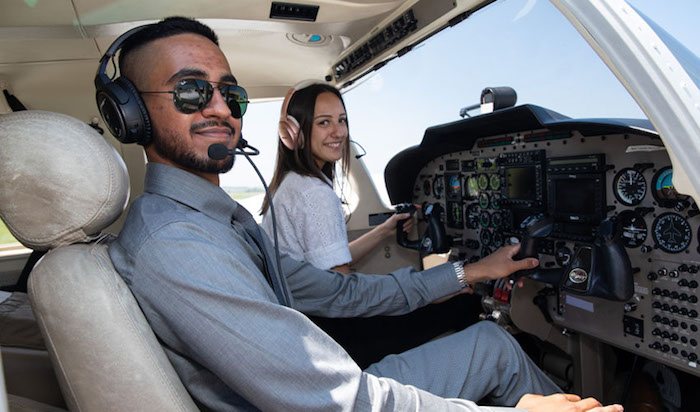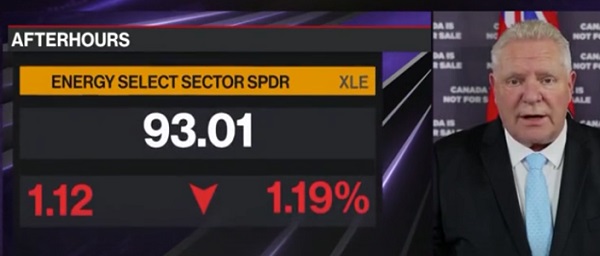Alberta
Province announces $11 million investment to train Albertans to work in aviation industry

Helping Alberta become Canada’s next aviation hub
The Ministry of Advanced Education is supporting Alberta’s growing aviation industry by investing more than $11 million over three years in Budget 2023.
Alberta continues to be the economic engine of Canada, and Alberta’s government is focused on even more job creation and diversification. Last fall, Alberta’s government signed a memorandum of understanding with WestJet Airlines, recognizing the importance of Alberta’s aviation industry and its contributions to the economy.
Part of the framework of the MOU included a commitment to address critical skilled labour shortages currently faced by the aviation industry. Alberta is home to the second-largest Canadian airline, which operates almost 800 flights carrying 70,000 passengers daily. These numbers are expected to double over the coming years.
That’s why Alberta’s government is committed to growing and diversifying its aerospace, aviation and logistics sectors. This new investment of $11 million includes:
- $6 million over three years to help Mount Royal University establish a bachelor of aviation management program
- $4.5 million over three years for an air access bursary for students in high-demand aviation programs
- $500,000 to support planning of an aviation centre of excellence
“These investments will help ensure Alberta’s air industry has the resources and workforce it needs to succeed, further supporting the growth and vitality of Alberta’s aviation industry, the diversifying of our economy and leading more students to successful careers.”
Supporting new seats in aviation education
Mount Royal University’s bachelor of aviation management program will add 120 seats over four years and be the first of its kind in Alberta. Unlike the aviation diploma, students seeking admission do not have to have a private pilot’s licence.
“We thank the Government of Alberta for this support of Mount Royal’s aviation program and the future pilots it educates. With the demand for pilots continuing to grow, this announcement speaks to the strength of the program, the vital role of education in advancing the aviation sector and its importance to the economy of Alberta.”
Tim Rahilly, president and vice-chancellor, Mount Royal University
The proposed program is a standard 120-credit degree. While there is only a generalized major, aviation management, the institution is offering the program with two different six-course concentrations.
One concentration in flight crew operations offers a commercial pilot and multi-engine instrument rating course to prepare students for a role as a pilot as well as other courses designed to prepare them for management opportunities as their flying career develops. The other concentration in aviation operations focuses on a greater development of management skills and specific aviation business content.
New bursary for aviation students
The new air access bursary provides $10,000 in non-repayable support for aviation students at Alberta post-secondary institutions. A total of $4.5 million will support up to 450 students over three years.
“Aviation is a growing field and the demand for pilots continues to soar. We thank the Government of Alberta for their financial support for students like me in the aviation program at Mount Royal University.”
Creating a hub for excellence
Alberta’s government is working across multiple ministries to support its air access expansion strategy as part of the memorandum of understanding with WestJet Airlines. Through this strategy, Alberta’s government is looking to boost the provincial economy by more than 1,000 direct jobs in Alberta and tens of thousands of other new jobs and billions in new economic activity. Pending approval, $500,000 will support planning for the centre of excellence for aviation training.
“The memorandum of understanding between the Government of Alberta and WestJet sets a foundation to support aviation-related post-secondary programs and improve skilled labour in the industry. This announcement strengthens these commitments and WestJet applauds the Government of Alberta for this funding that will further support WestJet’s Center of Excellence for advanced aviation training right here in Alberta.”
Alberta is proving to be Canada’s next aviation hub and Alberta’s government continues to build and create new partnerships with the aviation industry and Alberta’s post-secondary institutions. Another key partnership in the province’s aviation industry exists between De Havilland and SAIT, focusing on aircraft manufacturing.
“This investment in critical skills and training comes at a time when our company is actively growing our Alberta footprint to advance our mission of manufacturing great Canadian aircraft that serve communities, transport passengers and save lives around the world. We look forward to continuing to work with the Government of Alberta to ensure we have the trained staff we need to deliver a new aerospace sector in the province.”
Budget 2023 secures Alberta’s future by transforming the health-care system to meet people’s needs, supporting Albertans with the high cost of living, keeping our communities safe and driving the economy with more jobs, quality education and continued diversification.
Quick facts
- Alberta’s aviation, aerospace and logistics industries employ more than 75,000 people (2021, Statistics Canada).
- This investment expands on the October 2022 announcement that invested more than $8 million over three years to expand several key facilities and added 40 seats per year to Mount Royal University’s aviation diploma program.
- A 2018 report from the Canadian Council for Aviation and Aerospace found that Canada’s aviation industry will need as many as 7,300 more pilots by 2025.
Alberta
Big win for Alberta and Canada: Statement from Premier Smith

Premier Danielle Smith issued the following statement on the April 2, 2025 U.S. tariff announcement:
“Today was an important win for Canada and Alberta, as it appears the United States has decided to uphold the majority of the free trade agreement (CUSMA) between our two nations. It also appears this will continue to be the case until after the Canadian federal election has concluded and the newly elected Canadian government is able to renegotiate CUSMA with the U.S. administration.
“This is precisely what I have been advocating for from the U.S. administration for months.
“It means that the majority of goods sold into the United States from Canada will have no tariffs applied to them, including zero per cent tariffs on energy, minerals, agricultural products, uranium, seafood, potash and host of other Canadian goods.
“There is still work to be done, of course. Unfortunately, tariffs previously announced by the United States on Canadian automobiles, steel and aluminum have not been removed. The efforts of premiers and the federal government should therefore shift towards removing or significantly reducing these remaining tariffs as we go forward and ensuring affected workers across Canada are generously supported until the situation is resolved.
“I again call on all involved in our national advocacy efforts to focus on diplomacy and persuasion while avoiding unnecessary escalation. Clearly, this strategy has been the most effective to this point.
“As it appears the worst of this tariff dispute is behind us (though there is still work to be done), it is my sincere hope that we, as Canadians, can abandon the disastrous policies that have made Canada vulnerable to and overly dependent on the United States, fast-track national resource corridors, get out of the way of provincial resource development and turn our country into an independent economic juggernaut and energy superpower.”
Alberta
Energy sector will fuel Alberta economy and Canada’s exports for many years to come

From the Fraser Institute
By any measure, Alberta is an energy powerhouse—within Canada, but also on a global scale. In 2023, it produced 85 per cent of Canada’s oil and three-fifths of the country’s natural gas. Most of Canada’s oil reserves are in Alberta, along with a majority of natural gas reserves. Alberta is the beating heart of the Canadian energy economy. And energy, in turn, accounts for one-quarter of Canada’s international exports.
Consider some key facts about the province’s energy landscape, as noted in the Alberta Energy Regulator’s (AER) 2023 annual report. Oil and natural gas production continued to rise (on a volume basis) in 2023, on the heels of steady increases over the preceding half decade. However, the dollar value of Alberta’s oil and gas production fell in 2023, as the surging prices recorded in 2022 following Russia’s invasion of Ukraine retreated. Capital spending in the province’s energy sector reached $30 billion in 2023, making it the leading driver of private-sector investment. And completion of the Trans Mountain pipeline expansion project has opened new offshore export avenues for Canada’s oil industry and should boost Alberta’s energy production and exports going forward.
In a world striving to address climate change, Alberta’s hydrocarbon-heavy energy sector faces challenges. At some point, the world may start to consume less oil and, later, less natural gas (in absolute terms). But such “peak” consumption hasn’t arrived yet, nor does it appear imminent. While the demand for certain refined petroleum products is trending down in some advanced economies, particularly in Europe, we should take a broader global perspective when assessing energy demand and supply trends.
Looking at the worldwide picture, Goldman Sachs’ 2024 global energy forecast predicts that “oil usage will increase through 2034” thanks to strong demand in emerging markets and growing production of petrochemicals that depend on oil as the principal feedstock. Global demand for natural gas (including LNG) will also continue to increase, particularly since natural gas is the least carbon-intensive fossil fuel and more of it is being traded in the form of liquefied natural gas (LNG).
Against this backdrop, there are reasons to be optimistic about the prospects for Alberta’s energy sector, particularly if the federal government dials back some of the economically destructive energy and climate policies adopted by the last government. According to the AER’s “base case” forecast, overall energy output will expand over the next 10 years. Oilsands output is projected to grow modestly; natural gas production will also rise, in part due to greater demand for Alberta’s upstream gas from LNG operators in British Columbia.
The AER’s forecast also points to a positive trajectory for capital spending across the province’s energy sector. The agency sees annual investment rising from almost $30 billion to $40 billion by 2033. Most of this takes place in the oil and gas industry, but “emerging” energy resources and projects aimed at climate mitigation are expected to represent a bigger slice of energy-related capital spending going forward.
Like many other oil and gas producing jurisdictions, Alberta must navigate the bumpy journey to a lower-carbon future. But the world is set to remain dependent on fossil fuels for decades to come. This suggests the energy sector will continue to underpin not only the Alberta economy but also Canada’s export portfolio for the foreseeable future.
-

 2025 Federal Election18 hours ago
2025 Federal Election18 hours agoMORE OF THE SAME: Mark Carney Admits He Will Not Repeal the Liberal’s Bill C-69 – The ‘No Pipelines’ Bill
-

 International1 day ago
International1 day agoTrump’s ‘Golden Dome’ defense shield must be built now, Lt. Gen. warns
-

 2025 Federal Election2 days ago
2025 Federal Election2 days agoPM Carney’s Candidate Paul Chiang Steps Down After RCMP Confirms Probe Into “Bounty” Comments
-

 2025 Federal Election16 hours ago
2025 Federal Election16 hours ago‘Coordinated and Alarming’: Allegations of Chinese Voter Suppression in 2021 Race That Flipped Toronto Riding to Liberals and Paul Chiang
-

 2025 Federal Election12 hours ago
2025 Federal Election12 hours ago‘I’m Cautiously Optimistic’: Doug Ford Strongly Recommends Canada ‘Not To Retaliate’ Against Trump’s Tariffs
-

 2025 Federal Election2 days ago
2025 Federal Election2 days agoLiberal MP Paul Chiang Resigns Without Naming the Real Threat—The CCP
-

 2025 Federal Election2 days ago
2025 Federal Election2 days agoFight against carbon taxes not over yet
-

 Business2 days ago
Business2 days agoSaskatchewan becomes first Canadian province to fully eliminate carbon tax





